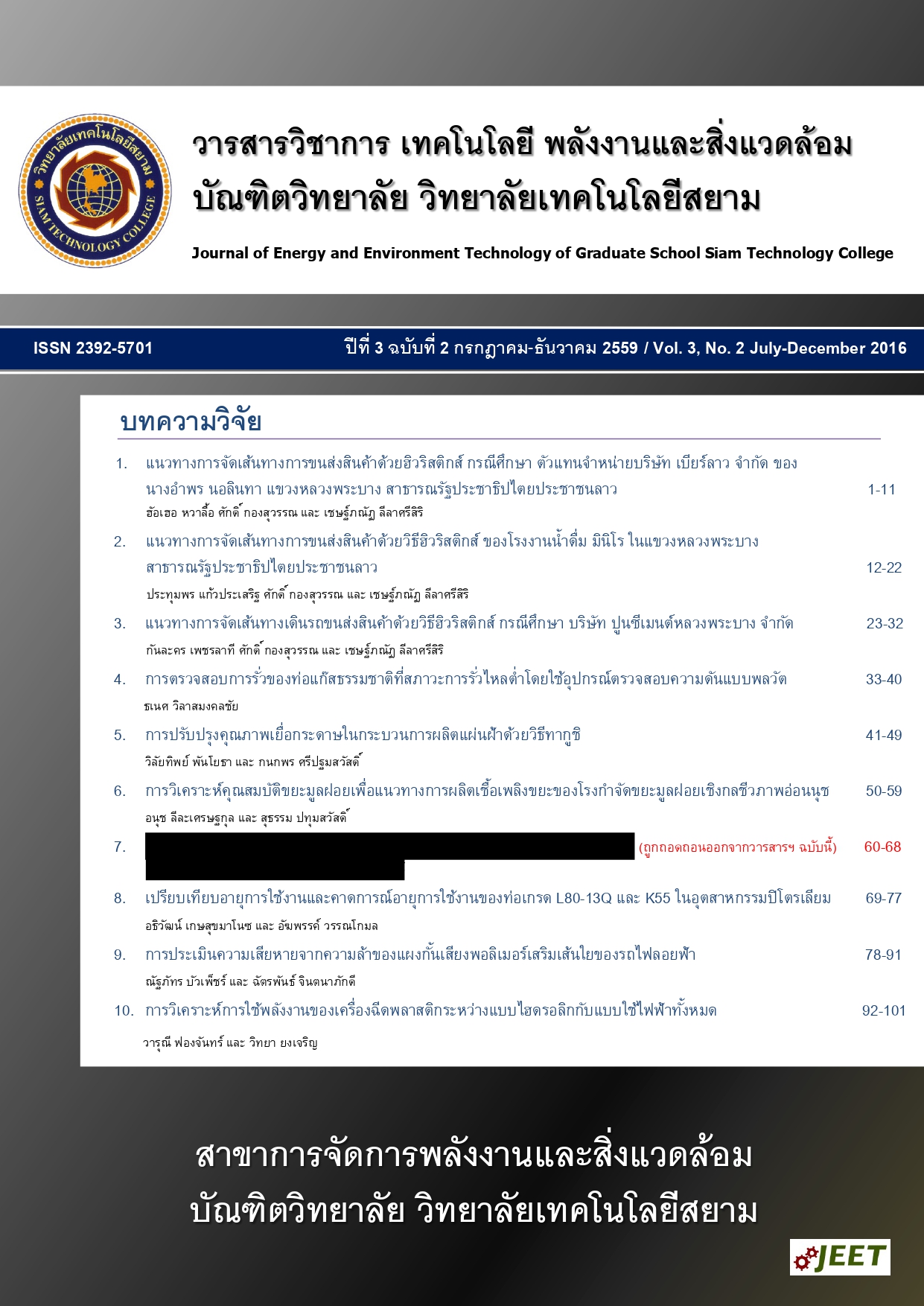เปรียบเทียบอายุการใช้งานและคาดการณ์อายุการใช้งานของท่อเกรด L80-13Q และ K55 ในอุตสาหกรรมปิโตรเลียม
Main Article Content
บทคัดย่อ
งานวิจัยนี้มีวัตถุประสงค์เพื่อศึกษาอัตราการกัดกร่อน และคาดการณ์อายุการใช้งานของท่อเกรด L80 - 13Cr และ K55 ตามาตรฐาน API 5CT ที่ใช้ในกระบวนการขุดเจาะและผลิต ในอุตสาหกรรมปิโตรเลียม โดยใช้ หลักการไฟฟ้าเคมีในการศึกษา ที่เป็นผลเนื่องมาจากน้ำในแหล่งหินกักเก็บที่ได้แยกขั้นออกจากน้ำมันดิบในท่อที่ ขุดเจาะแนวนอนภายใต้ อุณหภูมิห้อง, ความดันบรรยากาศ และได้ทำการศึกษาอัตราการกัดกร่อนที่ความหยาบ ผิวที่แตกต่างกัน ด้วยการเตรียมพื้นผิวขั้นงานทดสอบด้วยกระทราบเบอร์ 1200 และ 600 ตามลำดับ จากการ ทดลองพบว่าอัตราการกัดกร่อนของท่อเกรด L80-13Cr ที่ผ่านการเตรียมผิวที่กระดาษทรายเบอร์ 1200 และ 600 มีอัตราการกัดกร่อน คือ 0.0376 และ 0.0465 มิลลิเมตรต่อปี ตามลำดับ และอัตราการกัดกร่อนของท่อเกรด K55 ผ่านการเตรียมผิวที่กระดาษทรายเบอร์ 1200 และ 600 มีอัตราการกัดกร่อน คือ 0.0138 และ 0.0169 มิลลิเมตร ต่อปี ตามลำดับ ดังนั้นจึงสรุปได้ว่าท่อเกรด L80-13Cr มีพฤติกรรมต้านทานการกัดกร่อนได้ดิกว่า ท่อเกรด K55 เป็นผลเนื่องมากจากท่อเกรด L80-13Cr มีธาตุโครเมียมเป็นธาตุผสมอยู่ ซึ่งธาตุโครเมียมเป็นธาตุผสมที่มีอิทธิพล ช่วยต้านทานการกัดกร่อน (CRAs) และเมื่อพิจารณาที่ความหยาบผิว ค่าอัตราการกัดกร่อนที่กระดาษทรายเบอร์ 1200 มีอัตราการกัดกร่อนที่ตํ่ากว่าอัตราการกัดกร่อนที่กระดาษทรายเบอร์ 600 เพราะฉะนั้นจึงสรุปได้ว่า ท่อที่มี การเตรียมผิวที่ดิกว่าจะมีพฤติกรรมต้านทานการกัดกร่อนได้ดิกว่าเช่นกัน และจากค่าการกัดกร่อนที่ได้สามารถ น่าไปคาดการณ์อายุการใช้งานของท่อทั้งสองชนิดได้ดังนี้ ท่อ L80-13Cr ที่การเตรียมผิวด้วยกระดาษทรายเบอร์ 1200 และ 600 คือ 58.70 และ 47.93 ตามลำดับ และที่ท่อ K55 ที่การเตรียมผิวด้วยกระดาษทรายเบอร์ 1200 และ 600 คือ 21.54 และ 17.42 ตามลำดับ
Article Details
เนื้อหาและข่อมูลในบทความที่ลงตีพิมพ์ในวารสารวิชาการ เทคโนโลยี พลังงาน และสิ่งแวดล้อม บัณฑิตวิทยาลัย วิทยาลัยเทคโนโลยีสยาม ถือเป็นข้อคิดเห็นและความรับผิดชอบของผู้เขียนบทความโดยตรง ซึ่งกองบรรณาธิการวารสารไม่จำเป็นต้องเห็นด้วย หรือว่าร่วมรับผิดชอบใด ๆ
บทความ ข้อมูล เนื้อหา รูปภาพ ฯลฯ ที่ได้รับการตีพิมพ์ในวารสารวิชาการ เทคโนโลยี พลังงาน และสิ่งแวดล้อม บัณฑิตวิทยาลัย วิทยาลัยเทคโนโลยีสยาม ถือเป็นลิขสิทธิ์ของวารสารวิชาการ เทคโนโลยี พลังงาน และสิ่งแวดล้อม บัณฑิตวิทยาลัย วิทยาลัยเทคโนโลยีสยาม หากบุคคล หรือหน่วยงานใดต้องการนำทั้งหมด หรือส่วนหนึ่งส่วนใดไปเผยแพร่ต่อ หรือเพื่อกระทำการใด ๆ จะต้องได้รับอนุญาต เป็นลายลักษณ์อักษรจากวารสารวิชาการ เทคโนโลยี พลังงาน และสิ่งแวดล้อม บัณฑิตวิทยาลัย วิทยาลัยเทคโนโลยีสยาม เท่านั้น
เอกสารอ้างอิง
[2] Beavers, J. (2000). Fundamentals of corrosion. เท Peabody’s Control of Pipeline Corrosion, 2nd ed., R. Bianchetti, 297 - 317. Houston, TX: NACE International.
[3] Blackburn, N.A. (1994). Downhole Material Selection for Clyde Production Wells. Theory and Practice. SPE 27604.
[4] Chen, c. F., Lu, M. X., B., et al., (2005). Effect of Chromium on the Pitting Resistance of Oil Tube Steel in a Carbon Dioxide Corrosion System. Corrosion (Vol. 61, pp. 596-601). NACE International, Houston, TX.
[5] De Waard, c., Lotz, บ. and Milliams, D.E. (1991). Predictive Model for C02 Corrosion Engineering in Wet Natural Gas Pipelines Corrosion. 47(12): 976. NACE International, Houston, TX.
[6] Fontana, M.G. (1986). Corrosion Engineering. New York: McGraw-Hill.
[7] Heidersbach, R. (2011). Metallurgy and corrosion control in oil and gas production.
[8] Kane, R. (2006). Corrosion in Petroleum Production Operations. Metals Handbook, (Vol. 13C) Corrosion: Corrosion in Specific Industries. Metals Park, OH: ASM International (pp. 922-9


